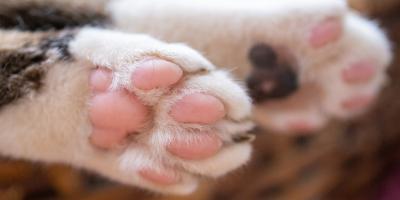How to Trim Cat Nails: Step-By-Step


Trimming your cat’s nails can be done at home with the proper equipment, a little patience, and lots of treats. Follow these tips and step-by-step instructions for the best way to trim a cat’s nails.
How Often Should You Trim Your Cat’s Nails?
How often you should trim your cat’s claws depends on your cat and her environment. Generally, clipping cat nails is part of the routine grooming you should provide your cat. To keep your cat’s nails super short so she can’t destroy your furniture, you might want to clip her claws once every three to four weeks.
If your cat has access to scratchers that naturally keep her nails short, like tree trunks or grit paper, you might be able to go a little longer between pedicures. To keep her claws from growing too long, you should trim them every couple of months. That way, you can be confident that your cat won’t get her nails caught on carpets and other fabrics, which can cause her nails to split or break.
Do cats shed their claws? Yes, they do. Unlike dog nails, cat claws grow in layers, and those layers are periodically shed. As a cat’s claws grow, the outer layers fall off, leaving a sharper claw underneath. If you own a cat, you’ve probably found loose, discarded nails on the floor or in the carpet. It’s all perfectly natural. Trimming cat claws regularly can speed up this process, helping the outer nails shed faster.
Why do cats scratch? All cats need to scratch. It’s how they take care of their nails, stretch their bodies, and mark their territory.
Cats with access to the outdoors will use a tree or stump for scratching, which will naturally trim their nails. Indoor cats will use your furniture if they don’t have a scratching post or cardboard scratcher that they’ve been trained to use. Some cats prefer vertical scratching posts that mimic the tree shape, while others prefer scratchers on the ground. But even cats with access to tree bark may need help keeping their back claws and dewclaws, the claws on the inner side of the foot, trimmed.
How many claws do cats have? That depends on how many toes they have. A typical cat will have 18 claws, five on each front limb and four on each back limb. The front limb claws include four between her toes and one dewclaw. Dewclaws on cats, also part of the cat claw anatomy, are located on the inner side of each foot. Polydactyl cats—those with extra toes like the famous Hemingway cats—may have six or more claws on each foot.
While tree bark can help dull a cat’s nails, scratching posts made of sisal rope, carpet, or cardboard won’t keep them dull and trimmed. There are scratchers made with different grit sandpapers that can help file your cat’s front nails, and some cats really enjoy them.
How Do You Know When Your Cat’s Nails Are Too Long?
There are several ways to know when your cat’s claws have grown too long and need a trim. Cat claws are retractable, which allows them to stalk their prey stealthily. If you hear your cat’s claws tapping on hard surfaces or catching on the carpet, it’s time for a trim. Likewise, if your cat’s claws are easily visible when her paws are relaxed, it means they’ve grown too long.
What happens if you don’t trim your cat’s nails? Overgrown cat claws can endanger your cat by getting caught on fabric or rugs. Nails that are too long can become ingrown, causing pain and possible infections. If you see your cat limping, constantly biting or licking her paw, or repeatedly lifting her paw while she’s sitting, take her to your vet. She might have an ingrown nail or nail-bed infection, which will require treatment. Learning how to clip your cat’s nails can help keep her feet and nails healthy.
A cat’s paw pads contain a large concentration of nerve receptors, making them extremely sensitive to touch. It’s another reason why they are such amazing predators – they can feel texture, pressure, and vibrations through their paws. Because a cat’s paws are so sensitive, getting your cat used to having her paws handled may take some time.
It’s important to get your cat used to having her paws touched before you try to trim her nails. Start with slight touching on the paws when your cat is lying in front of you or rubbing against you for attention. Then gently hold a paw, one at a time, for a few seconds while giving her some treats. Of course, if you begin this when she is a kitten, she’ll be more likely to accept it as an adult. But even adult cats can get used to it with enough time and treats.
Preparing to Trim Your Cat’s Nails
Can you clip cat nails with human clippers? No, you should only use clippers specifically designed to cut cat claws. Human clippers can split your cat’s nails, which can be painful for your cat.
If you’ve never trimmed your cat’s nails before, ask your vet to recommend the best clippers for your cat and show you how it’s best done.
It’s easier to get cats used to nail trimming when they are kittens. But even kittens won’t like someone handling their feet, so they need to get used to that first.
If you have patience, adult cats can be taught to not fear the nail clippers. Practice touching and holding your cat’s feet without the clippers first and reward them with treats after every step.
- Put your cat in the position you want, on your lap, between your legs, or on a flat surface, like an ironing board, for clipping.
- Hold her paw and touch her feet first without the clippers.
- Then slowly introduce the clippers, clipping a tiny tip of only one nail at a time.
Remember to cut just a tiny tip of the nail. If you cut your cat’s nails too close to the quick, which is the pink vein you can see inside each nail, it will be extremely painful for your cat and can create unhealthy cat claws that may lead to infection.
Stay relaxed. Your cat will sense your fear or anxiety and most likely hide until the coast is clear.
Supplies You’ll Need to Clip Cat Nails
Before you begin, make sure you have the right supplies. You’ll need:
- The right clippers for your cat
- Cotton balls or clean cloth
- Styptic powder – a clotting agent in case you hit the quick
- Cat treats
Can you restrain your cat for nail clipping? Only use the least amount of force necessary to restrain your cat. You don’t want to destroy your cat’s trust in you with harsh treatment or scruffing – holding them by the scruff of the neck.
Some people have success with cat grooming bags or suspended harnesses that allow the legs to hang out. If you’re using a harness that suspends from an indoor rod, like a shower curtain or tension rod, make sure the rod can support the weight of your cat.
A second person can help hold your cat steady while you clip her nails. That way, you can focus on holding one foot at a time. If that second person can also distract your cat with Fancy Feast Savory Purée lickable treats, that’s even better.
How to Trim a Cat’s Claws, Step-By-Step
Here is a step-by-step guide to the best way to clip your cat’s nails.
- Step 1: Sit down with your cat across your lap or lying face up in the valley between your legs. You can also stand and have your cat on a flat surface. Many people use an ironing board, so when the cat starts squirming, they won’t slide or scratch the surface.
- Step 2: Hold your cat’s paw gently, but firmly, to extend the nail. Make sure none of your cat’s fur is in the way.
- Step 3: Place the clippers at the very edge of the nail to avoid clipping the quick.
- Step 4: Hold the trimmer at a 45-degree angle.
- Step 5: Clip only the tip of the nail at a time.
- Step 6: Finish all the nails you can before your cat starts getting impatient. Understand you may only be able to do one or two before she’s had enough. With time and practice, you’ll both become more comfortable with it. If she starts twitching her tail, growling, stiffening, or panting, stop clipping, let her go, and start at another time.
- Step 7: Give your cat plenty of treats and praise afterward.
What to Do if Your Cat’s Nail is Bleeding after Trimming
If you accidentally cut the quick, and your cat’s nail is bleeding, don’t panic. Pour some of the styptic powder directly on the wound to help with clotting and ease the pain. Cover with a cotton ball or bandage and apply pressure to the tip of the nail. The bleeding should stop within a few minutes. If it doesn’t stop, reapply the powder and pressure. If it’s still bleeding, call your vet.
Keep your cat calm and quiet so that the nail is not further damaged or injured with climbing or running. How long does it take a cat nail that’s cut too short to heal? Depending on the injury, it can take up to two weeks for the nail to grow long enough to protect the quick. The wound should stay bandaged to keep it clean and to keep your cat from licking it. There is a risk of infection from the environment or the bacteria in your cat’s mouth if the nail is not properly bandaged. Call your veterinarian if you notice any signs of swelling, pain, or discomfort, as these can be signs that the nail has become infected.
How to Trim a Cat’s Nails When She Won’t Let You
People often ask, “How can I trim my cat’s nails if she won’t let me?” If your cat doesn’t like you handling her paws or trimming her nails, take it slow and only do a few at a time.
A second person can help by holding your cat and distracting her with treats. That way, you only need to worry about holding the foot and trimming the nail, rather than holding the cat still as well.
You can try using a harness or a grooming bag, as suggested above. If she can’t see what you’re doing, she might be less anxious. Some cat owners try a stealth clip, which is waiting until she’s taking a nap before trying. You might only get to clip a couple of nails before she wakes up and takes off.
When all else fails, take her to a groomer.
When to Take Your Cat to the Vet for a Nail Trim
If your cat won’t calm down for you or a groomer, you may have to take her to a vet for nail clipping.
Your vet may have better luck keeping your cat calm. Cat owners will tell you how easy it is for vets and vet techs to trim their cats’ nails or give them pills, but when they try it at home, the cats do not behave. Some of that is due to the experience of the vet and the vet tech, and some of it is due to your cat being less comfortable in a strange location, and that makes them more docile. If your cat won’t sit still for a claw clipping at the vet, she may need to be given a sedative at the vet’s discretion.
Of course, if you must take your cat to the vet for some other reason, like an annual checkup, teeth cleaning or another health issue, ask them to clip your cat’s nails while she’s there.
The more you practice, the more experienced you’ll get at clipping your cat’s nails, and the more comfortable she’ll become with the procedure.
For more expert tips on grooming your cat, explore our other cat routine care articles.
Related articles

Earn myPurina Rewards with Every Purchase
Use your points for treats, toys, and gift cards with myPurina app.






